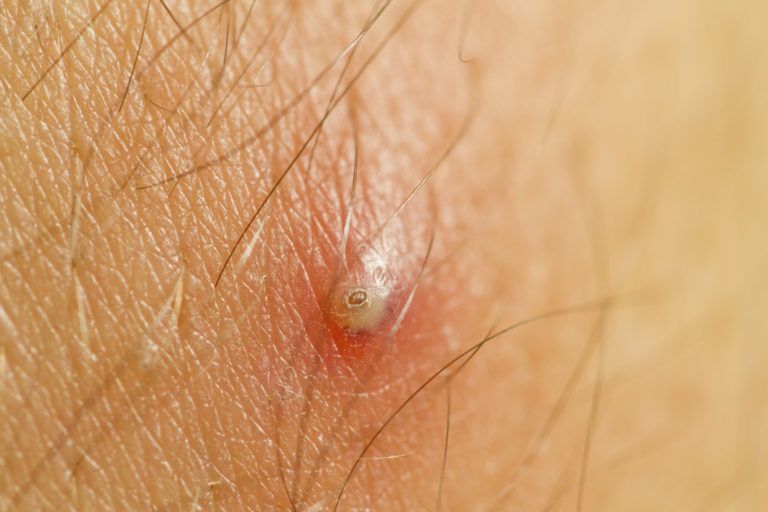
Yes, I’m a man and I trim the hedges once in a while. Let me tell you, ingrown hairs are nothing to scoff at. They itch like a mother and they can hurt like hell sometimes. Especially down there. But they’re easily cured, for most of us, with a warm cloth and a tweezers. Of course, there are those of us who who suffer from chronic ingrown hairs. More often than not these are people with naturally curly hair. Why? Because the most common cause, if not the definition of an ingrown hair, is a hair that has curled back and buried itself in your skin. It just makes sense that people with curly hair have a harder time trying to get rid of ingrown hairs.
So, I consulted a physician and what you have below are the results of that consultation. Be aware that these are the most general suggestions for getting rid of ingrown hair and any specific questions about ingrown hair should be addressed by a dermatologist.
Preventing and Treating Ingrown Hair
A proper shaving technique will prevent ingrown facial hair.
First, don’t shave so close the next time you put a razor to your face or your crotch. Leave a little hanging. Second, don’t shave against the grain of your hair growth (unless you like razor bumps). This applies to all areas of hair growth, including your legs. Third, and finally, don’t run your razor over the same spot in an effort to get that perfect shave. You’re just asking for ingrown hairs if you keep irritating that area with a blade.
Wearing looser clothing will prevent ingrown pubic hair.
This might be hard advice to swallow for those women who simply can’t go out in public without their camel toe prominently displayed for all to see. For the rest of us, it should be no surprise that wearing looser clothing will prevent ingrown hairs because you’re not pressing your hair against the skin. This is especially true after a fresh shave or bikini waxing.
The most common way to get rid of ingrown hair involves a warm compress and a sterilized tweezers.
If you can see the ingrown hair near the surface of the skin, apply a very warm, damp cloth for 15 minutes, or until the cloth cools. Then, if the skin has softened enough, dip a tweezers in rubbing alcohol to sterilize them and then gently pull the ingrown hair out of the follicle.
If recurrent ingrown hairs are a problem, use of an antiseptic may help prevent ingrown hair.
If you followed the suggestion above, it should be obvious that an antiseptic like rubbing alcohol, iodine, or peroxide should be dabbed on the wound to prevent infection. Chronic ingrown hairs are often a genetic issue, and so applying an antiseptic after each shave, or waxing should reduce them in people who are genetically predisposed.
Antibiotics won’t get rid of ingrown hairs, but they will get rid of an infected ingrown hair.
Most infections are caused by bacteria that get into the wound. If you dabbed antiseptic on the ingrown hair, it should be fine, but if it gets infected and the infection gets too painful or lasts more than a few days, you should go to the doctor and get a prescription for a mild antibiotic.
Best Ingrown Hair Treatment Products
Most ingrown hair treatment products are a kind of acid mixed with a moisturizer. The most common acids used are glycolic and salicylic acids. Glycolic acid, an alpha hydroxy acid otherwise known as fruit acid, is a mild exfoliating acid you will find in a plethora of skin care creams, cleaners, and moisturizer. It is often used to treat men’s beards and women’s bikini lines. It’s all natural, and is quickly becoming the most commonly used acid skin treatment because of its effectiveness. Look for treatments with no less than 10% concentration to ensure the prevention of ingrown hairs. Salicylic acid, similar to the active ingredient in aspirin, is used in a wide range of skin care products and engages the same basic process that glycolic acid does, exfoliating the skin to help clear pores and keep oils from building up in the hair follicles. So long as you are using these two acids to exfoliate your skin and treat ingrown hairs, you should see a noticeable reduction in the number of ingrown hairs.
Recurrent Ingrown Hair?
Permanent hair removal is always an option if ingrown hairs become a chronic condition. Mind you, permanent hair removal isn’t technically “permanent.” Permanent hair removal usually lasts no more than a year before you must undergo the process again. The most effective process at achieving permanent body hair removal is still electrolysis, but advances are being made in laser technologies that come close to achieving the same effects. If these ingrown hairs cause you a lot of troubles over time, you may want to check with a doctor.
Anyway, if you suffer from painful and recurrent ingrown hairs, it’s worth looking into a permanent hair removal procedure.
Best Natural Ingrown Hair Remedies
Tea Tree Oil
Tea Tree Oil as an antiseptic to be used after shaving is an effective, natural antimicrobial skin treatment when mixed with a carrier lotion like aloe. The antimicrobial properties of Tea Tree Oil make it a good alternative to commercial/chemical shaving lotions. You can find Australian Tea Tree spray on Amazon.
Witch Hazel
Witch Hazel, like Tea Tree Oil, is another natural antiseptic that can be used after shaving to help prevent bacteria from growing in your newly opened hair follicles and pores. Dickinson Brand products are the most popular name brand skin care products that use witch hazel as their active ingredients. You can find good cleanser pads from Dickinson’s at Amazon.
Kalo
Kalo is another all natural ingrown hair treatment solution, and is a natural alternative to other non-organic chemical ingrown hair solutions. It’s expensive, but it works.